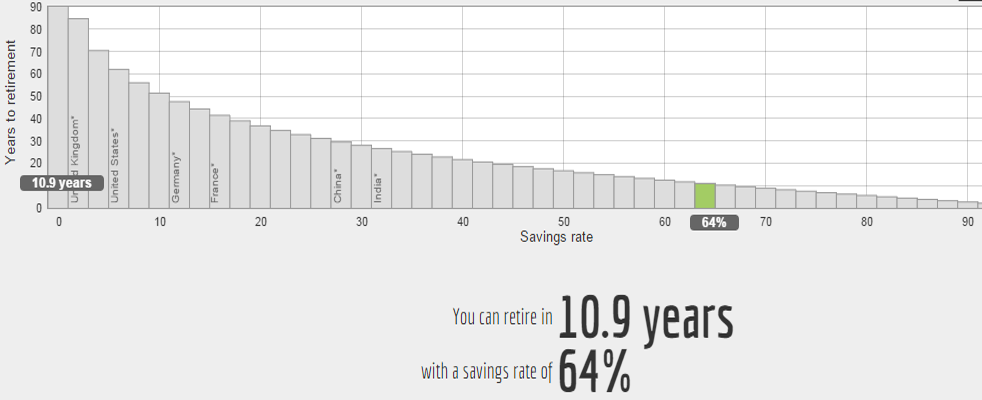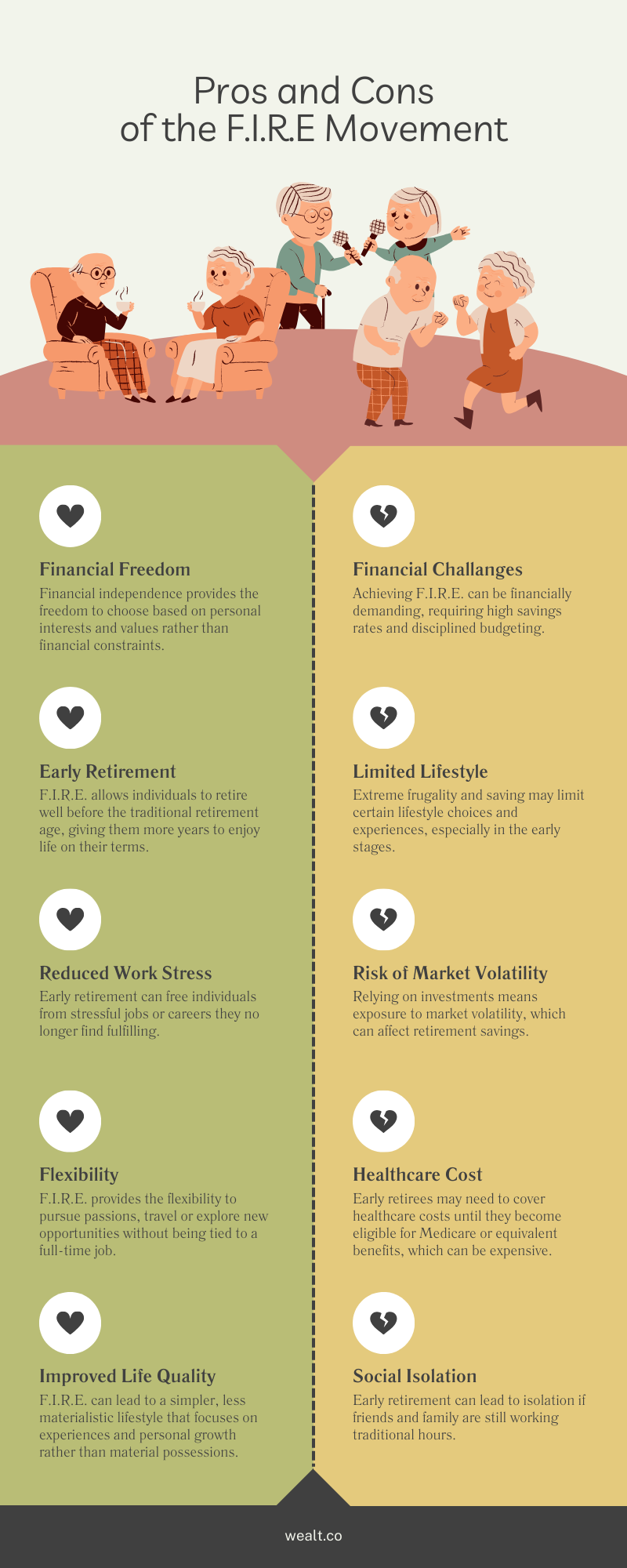The FIRE Path to Retirement Freedom
F.I.R.E. is a plan to retire early by saving aggressively and investing wisely to gain freedom from work and design your ideal life.

Financial Independence, Retire Early
That's everyone's dream. We all want to live a long life with financial freedom without thinking about money. We want to focus on our lives with dreams of early retirement.
F.I.R.E., an acronym for Financial Independence, Retire Early, is more than just a set of words; it's a dynamic lifestyle movement. Its primary mission? To empower individuals to control their time by becoming masters of their financial destiny. This fiery phenomenon has gained remarkable traction, particularly among millennials and Gen Xers, who are drawn to its principles of robust saving, deliberate spending and embracing frugality.
At its core, F.I.R.E. embodies a compelling concept: through dedicated saving and strategic investing, you can achieve financial independence early, free from the constraints of the typical 9-to-5 grind. While the path it charts may not suit everyone and often involves a reputation for extreme frugality, the fundamental principles and underlying mathematics have the potential to illuminate new possibilities for anyone striving to secure their retirement dreams.
Mr. Money Mustache
Mr. Money Mustache (MMM) is the online platform and alias of Peter Adeney, a Canadian-born blogger who achieved early retirement at the age of 30. A former software engineer, Adeney achieved this feat by living on a frugal portion of his annual income and consistently putting the surplus into investments, primarily stock market index funds.
We will discuss his famous article, The Shockingly Simple Math Behind Early Retirement. MMM discusses achieving early retirement and financial independence within 10 years.
The power of savings rate
It is a global fact that you need to save to increase your wealth. But the crucial question here is determining what percentage you need to save. MMM draws a graph showing the relationship between retirement years and savings rates.
“If you are spending 100% (or more) of your income, you will never be prepared to retire unless someone else is doing the saving for you (wealthy parents, social security, pension fund, etc.). So your work career will be Infinite.
While stating the outliers may not apply to most of us, knowing that the saving rate clearly draws the hard bargain on your retirement age is a key phenomenon.
If you are spending 0% of your income (you live for free somehow) and can maintain this after retirement, you can retire right now. So your working career can be Zero.“

In F.I.R.E., individuals often set ambitious savings rate targets ranging from 50% to an impressive 70%. Achieving these savings rates often requires adopting unconventional strategies, such as "house hacking" - optimising one's living arrangements to save money, living without a car, carefully planning meals and curbing lifestyle inflation. While this level of frugality may not resonate with everyone, it offers valuable lessons and inspiration for anyone on the path to financial security and retirement.
It is a numbers game
One of the most profound and liberating concepts espoused by the F.I.R.E. movement is that retirement isn't tied to age; it's tied to a number. F.I.R.E. enthusiasts firmly believe that having accumulated enough savings to generate a passive income sufficient to cover living expenses is the gateway to retirement, whether you are 30, 40, 50 or 60. For a retired two-person household, the annual expenses are around £19,000 in essential, while this number increases to £44,000 in luxury. This shift in perspective dispels the conventional notion that individuals must remain in the workforce until they reach a pre-determined retirement age.
.png)
Their financial independence number is a central pillar of the F.I.R.E. philosophy, often in line with the 4% rule. According to this rule, by limiting annual withdrawals to just 4% of your retirement nest egg, your funds should last throughout your retirement, even if you choose to retire early. Calculating your financial independence figure is simple: multiply your annual expenditure by a factor of 25:
Annual Expenditure x 25 = Your Financial Independence Number
.png)
Once you cross this financial threshold, you will have the freedom to retire early, as you can withdraw sufficient funds each year to cover your expenses, making traditional employment unnecessary.
Withdrawal rate and success
One of the cornerstones of the F.I.R.E. movement is the concept of withdrawal rates. This critical element determines how much you can safely withdraw from your investment portfolio during retirement while ensuring your money lasts. It's a make-or-break factor that can mean the difference between a secure and comfortable early retirement and a precarious financial situation.
The most commonly cited guideline is the Safe Withdrawal Rate (SWR), typically around 4%. This means that you can withdraw 4% of the value of your investment portfolio each year, adjusted for inflation, and expect your savings to last for a 30-year retirement. However, many F.I.R.E. enthusiasts opt for even more conservative withdrawal rates, such as 3%, to provide financial security. Factors influencing your chosen withdrawal rate include the composition of your investment portfolio, the impact of inflation on your purchasing power, the length of your retirement and the performance of the financial markets. To increase the likelihood of a successful early retirement, it's essential to adjust your withdrawal strategy as needed, maintain an emergency fund, plan for healthcare expenses and remain financially flexible to meet unexpected challenges. Regularly monitoring your financial situation and making adjustments when necessary is essential to ensure that your early retirement dreams become a lasting and fulfilling reality.
.png)
But still, the success rate only tells part of the story. Another quite important metric is the worst duration of a scenario. This means after many months, the first failure can happen. Retirement timing becomes especially pertinent in the context of economic cycles, where savvy individuals consider the impact of market fluctuations on their financial well-being post-retirement. Economic cycles can influence investment returns, and retiring during an economic downturn might expose one's savings to lower initial withdrawal rates, potentially safeguarding the longevity of their portfolio.
.png)
Freedom over time
Inflation can erode the value of physical cash in a bank account over 40 years, making it insufficient for retirement. However, wisely saving and investing money in tax-advantaged retirement accounts, using the power of compounding, can provide a solid foundation for your retirement. Accounts like ISAs (Individual Savings Accounts) and workplace pension schemes have varying tax advantages. They also provide tax-free growth and the potential for compounding returns.
However, these accounts have annual contribution limits. If you've maxed out all your retirement options, you can turn to a regular brokerage investment account with no contribution limits. The choice of investments, whether stocks, bonds or funds such as ETFs, depends on your risk tolerance.
There are also a variety of tax-efficient investment vehicles available for alternative investments. These include ISAs such as the Innovative Finance ISA (IFISA) and Stocks and Shares ISA, the Enterprise Investment Scheme (EIS) and Seed Enterprise Investment Scheme (SEIS), and Venture Capital Trusts (VCTs). Another alternative investment, whisky and wine, which is generally classed as a 'wasting asset' (meaning it has a predictable life of 50 years or less), does not attract capital gains tax.
Still, it usually involves an aggressive approach tailored to your financial goals and circumstances.
"Control of your time is the highest dividend money can pay." - Morgan Housel, The Psychology of Money
The appeal of the F.I.R.E. movement lies in its adaptability; it doesn't adhere to a one-size-fits-all model. Implementing even a subset of its core principles can significantly alter your financial trajectory. You gradually gain more control over your time by reducing your spending, increasing your savings rate and improving your financial literacy. These newfound options manifest themselves in a more fulfilling career, the possibility of a mini-retirement, the exploration of part-time work, or the freedom to pursue your passions wholeheartedly.
Types of FIRE
Each type of F.I.R.E. strategy offers a unique route to financial independence and early retirement, allowing individuals to tailor their approach to their financial goals, risk tolerance and lifestyle preferences. The type of F.I.R.E. to pursue depends on personal circumstances and priorities, making it a highly customisable journey to financial freedom.
- LeanFIRE: Reach early retirement with extreme frugality and high savings.
- FatFIRE: Retire early with a larger nest egg for a luxurious lifestyle.
- CoastFIRE: Reach a point where investments cover retirement costs and allow for flexible working.
- BaristaFIRE: Work part-time in retirement to cover basic expenses.
- GeoFIRE: Retire early in a cheaper location.
- Coast to FatFIRE: Move from a basic retirement to a more comfortable one.
- SlowFIRE: Save gradually for mid-life or slightly earlier retirement.
Pros vs. cons of FIRE
There is something bad in every good thing. The F.I.R.E. movement is one of them. It offers the promise of financial freedom and early retirement. But it also requires strict financial discipline, risk management and consideration of potential downsides such as limited lifestyle choices and financial uncertainty.
Pros
- Financial freedom: Financial independence provides the freedom to choose based on personal interests and values rather than financial constraints.
- Early retirement: F.I.R.E. allows individuals to retire well before the traditional retirement age, giving them more years to enjoy life on their terms.
- Reduced work stress: Early retirement can free individuals from stressful jobs or careers they no longer find fulfilling.
- Flexibility: F.I.R.E. provides the flexibility to pursue passions, travel or explore new opportunities without being tied to a full-time job.
- Improved quality of life: F.I.R.E. can lead to a simpler, less materialistic lifestyle focusing on experiences and personal growth rather than material possessions.
Cons
- Financial challenges: Achieving F.I.R.E. can be financially demanding, requiring high savings rates and disciplined budgeting.
- Limited lifestyle: Extreme frugality and saving may limit certain lifestyle choices and experiences, especially in the early stages.
- Risk of market volatility: Relying on investments means exposure to market volatility, which can affect retirement savings.
- Healthcare costs: Early retirees may need to cover healthcare costs until they become eligible for Medicare or equivalent benefits, which can be expensive.
- Social isolation: Early retirement can lead to isolation if friends and family still work traditional hours.

Subsribe to our weekly newsletter
Get our Sunday morning newsletter with exclusive deals, portfolio updates, and private market insights delivered straight to your inbox.


.jpg)

